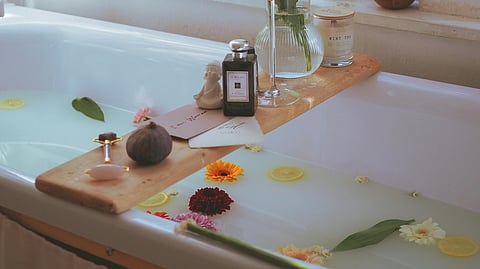
- LIFESTYLE
- FASHION
- FOOD
- ENTERTAINMENT
- EVENTS
- CULTURE
- VIDEOS
- WEB STORIES
- GALLERIES
- GADGETS
- CAR & BIKE
- SOCIETY
- TRAVEL
- NORTH EAST
- INDULGE CONNECT

Milk Bath is a simple skincare ritual with many benefits. From making your skin softer to soothing an irritated skin and even exfoliating it, leaving it softer than before; this is an easy, doable, skincare method that you must try out sometime. Several notable celebrities have reportedly applied the benefits of milk baths. While Kim Kardashian and Cardi B are known to have posted photographs, Madonna and Elizabeth Taylor also support it. Interestingly, this ritual of skin purification was also used by Megan Fox in the movie Jennifer’s Body and much before being a part of pop-culture and skincare, Egyptian Queen Cleopatra, was known to have mixed rose petals and honey to the world’s most expensive Donkey Milk for her bath rituals. This World Milk Day, lets recollect the significance of Milk Baths and take a look at how you can prepare one for yourself in your bathtub with simple ingredients.
What might first come to your mind when the word Milk Bath is used is a bathtub completely full of milk. The thought of the amount of milk required for the same and its price is good enough to start a fever. But this is common misconception. You do not need a full bathtub filled with milk. There are many other ingredients that go into the process of creating a milk bath. If you have a bathtub and want to experience it first-hand yourself, this is how to go about it.
Items needed:
• 2 cups of whole milk (or 1 cup powdered milk)
• ½ cup Epsom salt (optional)
• 2 tbsp honey
• 10 drops essential oil (of your choice)
• ½ cup oats (optional)
• Dried flowers/ rose petals/ lavender buds (optional)
Preparation:
· Fill warm water in your bathtub
· Add the milk and other ingredients to mix it well with the water
· Soak yourself for half an hour
· Pat yourself dry after you come out of the bath
· Moisturise to lock hydration.
Things to keep in mind:
• Full fat milk works the best on your skin
• Ideally do not add fragrance and if you must, then put skin-safe essential oils
• After the milk bath, clean the bathtub very well so that you do not slip or residue build up is not left
• Test any optional ingredients, in case you have allergies or extra sensitive skin
• Avoid Milk bath in case you are lactose intolerant unless cleared by medical practitioner.
Would Milk Bath actually benefit you
There are four main benefits of soaking yourself in a Milk Bath. First, it hydrates the skin. The fats and proteins present in milk helps to moisturise the skin which is otherwise dry, dull and at times flaky. No matter the season, summer or winter, Milk Baths work well in providing the right hydration to the skin.
Second, milk is considered as a natural ingredient for exfoliation of dry and dead skin cells. This is due to the alpha hydroxyl acid (AHA) present in Lactic Acid. This helps the skin quality as the dead skin cells are removed leaving you with glowing, brighter and softer skin.
Third, regular milk baths – definitely not every day, but once or twice a week- for a month or so leaves your skin softer than many additional products that you use to attain soft skin.
Fourth, milk has anti-inflammatory properties. It helps to soothe the irritation and itching for skin issues like sunburn, eczema and psoriasis. However, if you are lactose intolerant, then it is best to take expert opinion before opting for a milk bath treatment.